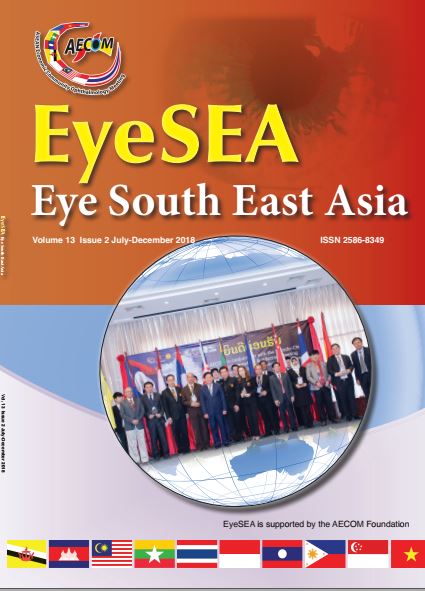How safe are coloured contact lenses illegally sold on street in Thailand?
Main Article Content
Abstract
Objectives: To assess the incidence of contamination from bacteria, fungus, and protozoa
in colored contact lenses illegally sold on the street in Thailand and to specify contaminated microbial species by microbial culture in order to generate empiric antimicrobial
guidelines.
Design: cross-sectional study
Methods: This is a cross-sectional study of colored contact lenses illegally sold in street
markets in 50 districts of Bangkok. We had 350 samples of colored contact lenses. All of
the colored contact lens samples underwent microbial culture using broth agar in the laboratory. We evaluated the safety of the samples by observing the number of colored contact
lenses that show positive microbial culture, reported as a percentage of all tested colored
contact lenses. We set an acceptable microbial growth value at 0.5%. If more than 0.5% of
all contact lens samples had positive microbial culture, we considered these contact lenses
contaminated and unsafe. Each positive bacterial growth sample would be confrmed by
subculture and the growing colony was evaluated and identifed by biochemical tests.
Results: The 350 samples of colored contact lenses were from 6 brands: 26 samples
of Barbie contact lens, 81 of Dream Color contact lens, 6 of Eye Berry contact lens, 34
of Kawaii contact lens, 6 of Lollipop contact lens, 8 of Mimi contact lens, 68 of Pretty
Doll contact lens, and 121 of Sweety Plus contact lens. All of the colored contact lenses
were made of Polyhema and immersed in normal saline. We performed microbial culture.
Brain heart infusion broth, which is specifc to growths of gram-positive bacteria, gramnegative bacteria, anaerobic bacteria, fungi, and protozoa
Conclusion: Our study shows no microbial growth in every sample so we can conclude
that colored contact lenses illegally sold on streets in Bangkok are uncontaminated.
Conflicts of interest: None
Article Details
References
2. Steinemann TL, Fletcher M, Bonny AE, Harvey RA, Hamlin D, Zloty P, et al. Over-the-counter decorative contact lenses: Cosmetic or Medical Devices? A Case Series. Eye Contact Lens 2005;31(5):194-200.
3. Booranapong W, Prabhasawat P, Kosrirukvongs P, Tarawatcharasart Y. Risk factors for contact lens related microbial keratitis: a casecontrol study. J Med Assoc Thai 2012;95(5):693-8.
4. Preechawat P, Ratananikom U, Lerdvitayasakul R, Kunavisarut S. Contact lens-related microbial keratitis. J Med Assoc Thai 2007;90(4):737-43.
5. Tsukiyama J, Miyamoto Y, Fukuda M, Miura H, Tsuchiya J, Shimomura Y. The effect on the shape of color soft contact lens caused by pigments. Nihon Ganka Gakkai Zasshi 2014;118(10):817-25.
6. Rah MJ, Schafer J, Zhang L, Chan O, Roy L, Barr JT. A meta-analysis of studies on cosmetically tinted soft contact lenses. Clin Ophthalmol 2013;7:2037-42.
7. Kishimoto K, Yoshida T, Fukushima N. Factors related to purchasing over-the-counter medications online. Yakugaku Zasshi 2009;129(9):1127-36.
8. Steinemann TL, Pinninti U, Szczotka LB, Eiferman RA, Price FWJ. Ocular complications associated with the use of cosmetic contact lenses from unlicensed vendors. Eye Contact Lens 2003;29(4):196-200.
9. Almesmary AA. Laboratory study of the cytotoxicity of colored soft contact lenses. Cesk Slov Oftalmol 1999;55(1):28-38.
10. Dart JK, Stapleton F, Minassian D. Contact lenses and other risk factors in microbial keratitis. Lancet 1991;338:650-3.
11. Nilsson SE, Montan PG. The annualized incidence of contact lens induced keratitis in Sweden and its relation to lens type and wear schedule: results of a 3-month prospective study. CLAO J 1994;20: 225-30.
12. Cheng KH, Leung SL, Hoekman HW, Beekhuis WH, Mulder PG, Geerards AJ, et al. Incidence of contact-lens-associated microbial keratitis and its related morbidity. Lancet 1999;354:181-5.
13. Edwards K, Keay L, Naduvilath T, Snibson G, Taylor H, Stapleton F. Characteristics of and risk factors for contact lens-related microbial keratitis in a tertiary referral hospital. Eye Lond 2009;23: 153-60.

